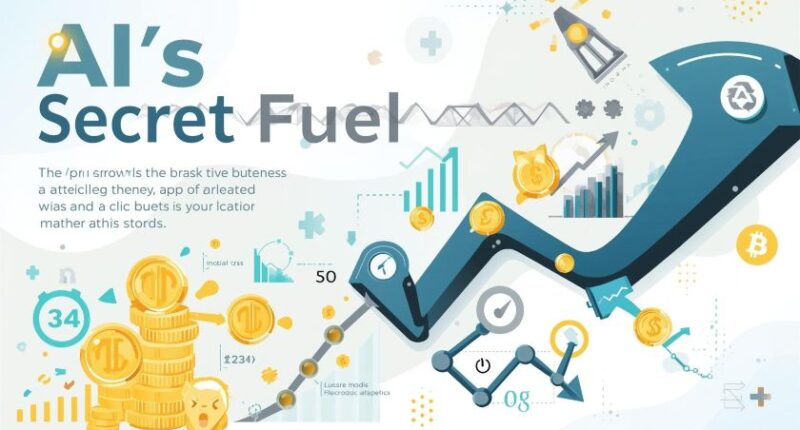Artificial Intelligence (AI) has become the centerpiece of global innovation, transforming industries from healthcare to finance. Most investors automatically think of semiconductors, chips, and tech giants when they hear “AI.” However, the real story is shifting — energy stocks are quietly becoming the smartest AI trade on Wall Street.
This article explores why AI is driving demand for energy, how investors are positioning themselves, and which energy opportunities are poised to benefit the most in 2025 and beyond.
Why Energy Is the Hidden Backbone of AI
AI Demands Massive Computing Power
AI models, particularly large language models and deep learning networks, require enormous computational resources. Data centers powering these models consume gigawatts of electricity, often comparable to small cities.
-
Fact: Training a single advanced AI model can use as much energy as hundreds of U.S. households consume in a year.
-
Implication: Tech companies must secure reliable and abundant energy sources to sustain AI growth.
Energy Costs Affect AI Profitability
Electricity costs represent a significant portion of operational expenses for AI companies. The higher the energy efficiency and lower the power cost, the more profitable AI operations become.
-
Smart investors realize: Companies supplying energy, renewable power, or energy infrastructure indirectly benefit from AI proliferation.
Wall Street’s Shift: From Chips to Energy
Traditional AI Investments
Historically, AI investment has focused on:
-
Semiconductor manufacturers (NVIDIA, AMD)
-
Cloud computing providers (AWS, Microsoft Azure, Google Cloud)
-
AI software companies
While these remain profitable, margins are increasingly constrained by energy costs and scalability limitations.
Energy Stocks Enter the Spotlight
Energy stocks — including utilities, renewable energy providers, and battery technology firms — are attracting attention from hedge funds and institutional investors.
-
Why now: AI adoption is skyrocketing globally, creating predictable, long-term energy demand.
-
Smart money is betting on companies that supply electricity, manage grids, and provide energy storage solutions.
Types of Energy Investments Driving AI Growth
1. Renewable Energy Providers
Renewable energy companies are crucial to AI operations, particularly those focused on:
-
Solar and wind farms powering data centers
-
Hydropower for stable, low-carbon energy
Investors see dual benefits:
-
AI expansion fuels demand
-
Green energy initiatives align with government incentives and ESG trends
2. Utilities and Grid Operators
Traditional utility companies that manage energy transmission and distribution are benefiting from AI’s growth indirectly.
-
Why it matters: AI infrastructure requires reliable, high-capacity electricity delivery.
-
Utility companies with modernized grids and AI integration capabilities are poised to outperform.
3. Energy Storage and Battery Companies
AI requires constant uptime, meaning reliable energy storage is critical. Battery manufacturers, lithium producers, and companies focused on grid-scale storage are increasingly attractive.
-
Example: Advanced battery systems allow data centers to operate efficiently even during peak demand.
-
Investors are recognizing storage as a growth engine tied to AI expansion.
The AI-Energy Feedback Loop
AI Optimizes Energy Usage
Interestingly, AI itself is being used to manage energy consumption more efficiently.
-
AI algorithms optimize data center cooling and server usage
-
Energy suppliers use AI for predictive maintenance and grid management
Mutual Growth
This creates a feedback loop:
-
AI needs more energy → drives demand for energy infrastructure
-
Energy companies adopt AI → improve efficiency → attract more AI clients
Investors see this mutually reinforcing cycle as a unique opportunity for long-term growth.
How Investors Are Positioning Themselves
Hedge Funds and Institutional Money
Wall Street hedge funds are quietly shifting capital into energy firms with AI-aligned growth potential. Key characteristics they look for include:
-
Stable cash flows
-
Strong ESG practices
-
Expansion in AI-heavy regions (e.g., Silicon Valley, Austin, Shenzhen)
Individual Investors
Retail investors can also tap into this trend via:
-
Energy ETFs focused on renewable power and battery technology
-
Individual stocks in utilities, storage, and renewable companies
-
Sustainable infrastructure funds that support AI-related energy growth
Risks and Considerations
Volatility in Energy Markets
Energy prices can fluctuate due to geopolitical events, weather, or policy changes. Investors must consider:
-
Hedging strategies
-
Diversification across energy types (renewables vs. traditional)
-
Exposure to long-term AI growth trends
Technological Disruptions
As AI becomes more efficient, energy demand growth could slow if companies adopt low-power chips or edge computing. Investors must monitor:
-
Advancements in energy-efficient AI
-
Regulatory changes favoring green energy solutions
Regulatory Environment
Government policies regarding carbon emissions, renewable subsidies, and energy tariffs significantly impact energy stocks. Investors should track policy shifts in:
-
United States
-
European Union
-
China and Asia-Pacific markets
Key Takeaways
-
AI’s growth is creating massive, predictable energy demand, benefiting energy companies.
-
Wall Street is increasingly investing in renewables, utilities, and storage solutions as AI expands.
-
The AI-energy feedback loop provides both efficiency and growth opportunities.
-
Investors must consider market volatility, technological changes, and regulation when allocating capital.
-
Energy stocks offer an alternative high-growth play for investors who traditionally focus on semiconductors and cloud providers.
Conclusion
While chips and cloud infrastructure dominate headlines in AI investing, energy is the unsung hero powering the AI revolution. From renewable energy farms to battery storage and utilities, companies that deliver reliable electricity are quietly capturing enormous growth opportunities.
For savvy investors in 2025, the lesson is clear: don’t just chase AI software and semiconductors — follow the electricity that fuels it. Understanding this shift can lead to smarter investment decisions and long-term portfolio gains.









